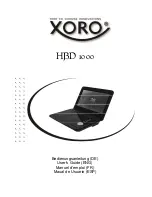
OPERATION
2-23
November 2001
Part No. 001-7240-001
mobile’s unique ID and the home repeater to be used.
The registration information is forwarded to the Call
Processor which then knows its location. This auto-
matic registration occurs regardless of whether
roaming is on or off.
If the signal from a locality becomes weak (see
“Dropout and Capture Parameters” which follows) or
if two consecutive unsuccessful access attempts occur,
“NO ACESS” is displayed and the transceiver begins
automatic locality search. The unsuccessful access
counter is reset whenever power is cycled, the selected
system is changed, or a successful access occurs.
During locality search, the status channels of
other LTR-Net localities in the system scan list are
checked (see Section 2.6.7). During the first pass,
“HSQ SRCH” (High Squelch Search) is displayed, the
locality that was just dropped is not checked, and the
Tight Squelch setting programmed for each locality is
used (see “Dropout and Capture Parameters” which
follows).
If no localities are found on the first pass that
have a high enough signal level, the locality that was
just dropped is added back into the search list and all
localities in the scan list are checked using the Capture
setting programmed for each locality. The display
indicates “LCL SRCH”, and searching continues until
a strong enough locality is found. If none are found
before the PTT switch is pressed again, the transmis-
sion is attempted on the last registered locality, and
searching resumes when the transmission ends.
De-Registering
If an LTR-Net system is selected when power is
turned off, a de-registration message is automatically
sent that tells the system that the mobile is no longer in
service. This increases system efficiency by reducing
the number of system resources used in trying to reach
out-of-service mobiles. Transceiver power is automati-
cally held on until this message is sent. If power to the
transceiver is switched off immediately, such as by
removing the battery, this message cannot be sent.
Revert System/Group Selection After Registration
After registration on a new locality occurs, “LCL
SRCH” is no longer displayed and the system of the
new LTR-Net locality is displayed. The new system is
the next higher system with a different locality that
could be accessed. For example, if System 3 was
selected and System 5 is the next higher system with a
different locality number, that becomes the selected
system if it can be accessed (wrap-around occurs after
the highest system is checked).
The selected group does not change when regis-
tration on a new locality occurs. This allows registra-
tion on a new locality to be nearly transparent to the
user. Therefore, when programming the transceiver,
the same group programming should be used in all
LTR-Net systems that a mobile roams into. If the same
group is not programmed in the new system, the last
selected group on the new system is selected. A call
can be received on the new locality before registration
occurs if the call is already active on the new locality.
Dropout and Capture Parameters
The transceiver squelch is used to control when
searching for a new locality begins and also when regis-
tration on a new locality occurs. A reference squelch
level is set during alignment. In addition, three squelch
levels called Dropout, Capture, and Tight Capture
Percentage are programmed for each locality (see Table
3-2). These levels automatically tighten the squelch
setting in certain operating modes. The tightened
amount is the programmed percentage of the difference
between the reference level and the maximum tight
setting (equivalent to rotating a squelch knob fully
clockwise). These squelch levels function as follows:
Dropout Percentage - This is the percentage that
squelch is tightened when not in a call. This prevents
the transceiver from staying on a weak locality when
another stronger locality may be nearby. The default
level is 33%, and setting higher levels may cause more
missed calls during weak signal periods. If there is no
other locality nearby, this parameter should be 0%.
Tight Capture Percentage - This is the percentage
the squelch is tightened during the first pass when
searching for a new locality (HSQ SRCH displayed).
This parameter should always be greater than or equal
to the Capture Percentage which follows, and it
ensures that registration occurs on a strong locality if
there is one. The default level is 80%.
















































